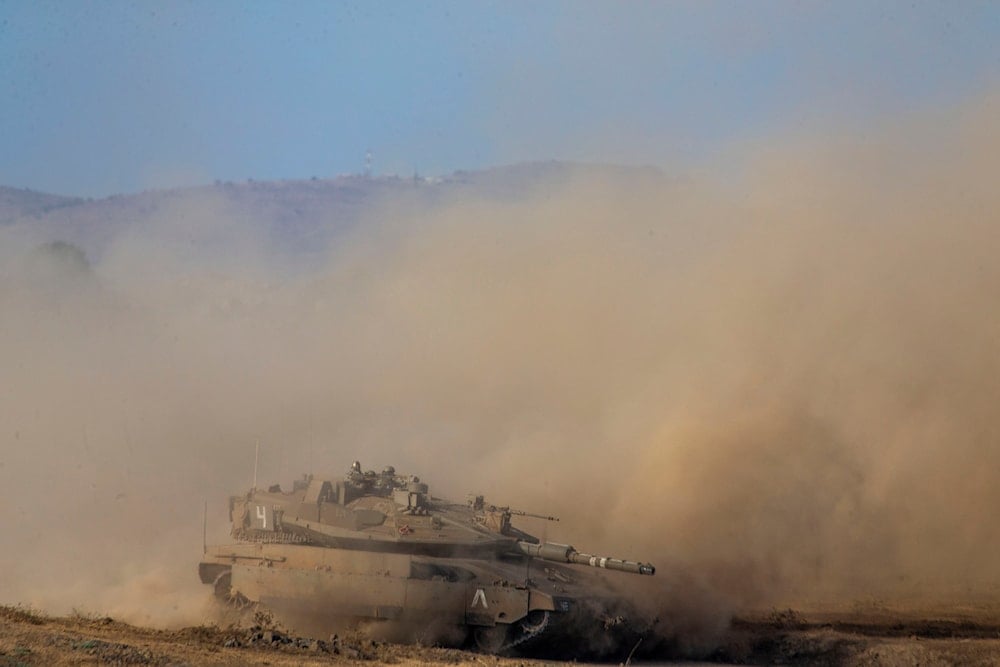IOF raids Quneitra countryside village, arrests young man
Israeli forces arrest a young man from the village of Taranja in the Quneitra countryside and take him to an undisclosed location after raiding the village this morning.
-

Israeli soldiers drive a tank during an exercise in the Israeli-controlled Golan Heights near the border with Syria, on August 4, 2020. (AP)
Israeli occupation forces (IOF) carried out a large-scale raid on the village of Taranja in the Quneitra countryside this morning, arresting a young man and taking him to an undisclosed location.
The incursion involved around 100 soldiers, supported by 20 military vehicles and reconnaissance aircraft that heavily patrolled the skies. Troops searched several civilian homes, assaulted residents, and withdrew after several hours.
This operation follows repeated Israeli incursions into Syrian territories in recent weeks. A day earlier, the Syrian Observatory for Human Rights reported that an Israeli force entered al-Samadaniyah al-Sharqiyah, searching five homes before retreating. In another incident, forces from the Tal Ahmar al-Gharbi base advanced toward the Briqa–Kodnah road, establishing a new military checkpoint.
Between June 9 and July 5, 2025, Israeli forces carried out at least 22 ground incursions into Quneitra, the Damascus countryside, and Daraa governorates, often conducting home demolitions, mass arrests, and temporary military checkpoints.
Expansion of IOF presence in southern Syria
The Quneitra raid reflects a broader campaign to cement Israeli control over southern Syria. Since the fall of Bashar al-Assad’s government in December 2024, Israeli forces have occupied nearly 500–600 square kilometers of territory, including approximately 95% of Quneitra Governorate.
The occupation stretches from Mount Hermon through Quneitra to Daraa, with ten permanent military bases established, six of them in the last three months. Strategic locations include Jubata al-Khashab, Qurs al-Nafal, al-Qahtaniyah, the eastern al-Ahmar hill, and Tulul al-Humr, the latter only 40 kilometers from Damascus.
Control over key water resources such as the Sheikh Hussein and Sahm Golan dams, the Yarmouk riverbed, and al-Wahda Dam has further consolidated the occupation’s grip on the region.
Israeli strategic objectives
The occupation is backed by "Operation Arrow of Bashan," launched immediately after Assad’s fall. Within eight days, Israeli forces conducted over 600 airstrikes, targeting airfields, missile sites, tanks, and Syria’s remaining air defense systems. This campaign destroyed between 70–80% of Syria’s strategic military capabilities, including its air force and naval fleet.
Ground operations have reached as close as 3 kilometers from Qatana city in the Damascus countryside and just 10 kilometers from the Yaafour area near the capital. These advances have pushed beyond the original buffer zone, signaling intent for long-term occupation.
In al-Hamidiyah village in al-Quneitra alone, 15 homes were demolished, displacing entire families. Across southern Syria, more than 6,000 people have been forced from their homes, 6,000 hectares of land have been confiscated, and agricultural areas have been deliberately destroyed.
Observers warn that the combination of military entrenchment, resource control, and systematic raids points to an indefinite occupation of southern Syria, one that continues despite international condemnation.

 3 Min Read
3 Min Read








